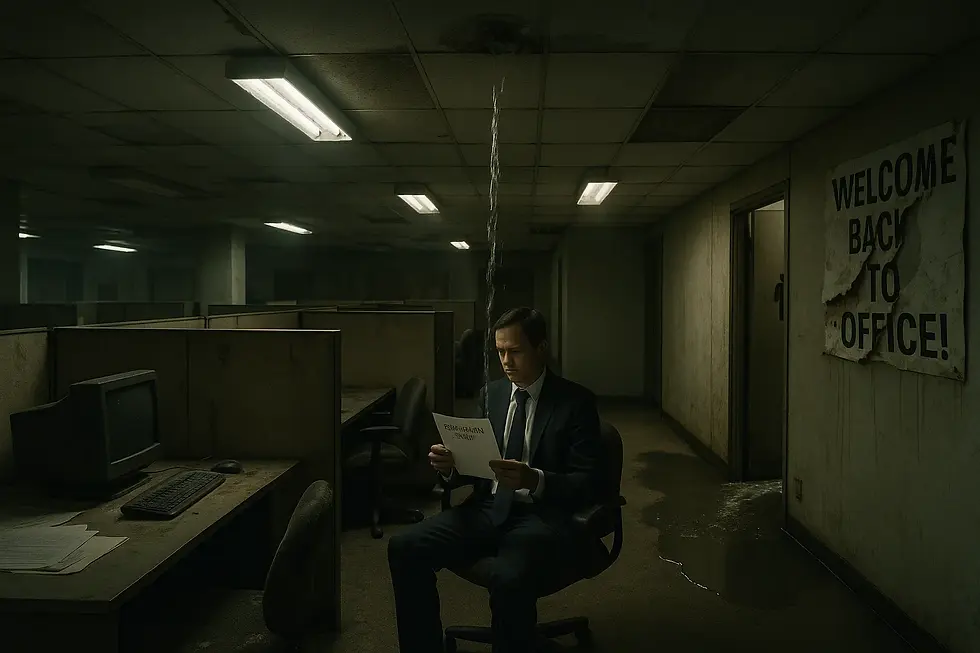RTO Policy is more like Back to the Office—So You’ll Quit Policy
- Robinson Joel Ortiz

- Jul 13
- 3 min read

In January 2025, the White House issued a sweeping directive: “heads of all departments and agencies … take all necessary steps to terminate remote work arrangements and require employees to return to work in-person … on a full‑time basis”. Ostensibly about collaboration and accountability, the mandate triggered a wave of closures, voluntary exits, and pink slips, especially within the government sector.
📉 Layoffs Without the Negative Optics
Following the return‑to‑office (RTO) push, many agencies proceeded to shed roughly 20% of their staff, with officials hinting at “more cuts unless volunteers step forward.” At the same time, support staff disappeared, leases were terminated, and essential tools vanished—a recipe for daily friction and frustration.
🧾 “Flush the Toilet” Reality Check
The analogy is apt: forcing workers back into neglected offices is like flushing a seldom‑used toilet—“when you start flushing a toilet that hasn’t been flushed much, shit starts happening.” The result? Infrastructure failures, chaotic restrooms, scarce supplies, and silence where water and flushing once were routine. NPR recently documented shortages of basic necessities in federal offices: desks, monitors, parking, and yes, even toilet paper.
💸 Who’s Actually Saving Money?
Despite claims of fiscal efficiency, the return‑to‑office push has coincided with costly real estate decisions:
• Agencies have reduced office holdings during 2020–2024, only to pause disposals in early 2025 to reassess space needs.
• The General Services Administration (GSA) launched “Space Match”—a tool to redistribute existing seating—not to expand it—while emphasizing cost reduction through shared office arrangements.
• Instead of reinvesting in buildings, agencies are trimming budgets, pulling back leases, and dismantling workplaces.
The math doesn’t add up: repeatedly shuffling costs, denying access to tools and upkeep, yet still paying (or overpaying) for space. Who truly saves?
🏦 Voices From the Banking Sector
Major banking executives have debated the shift back to offices, and the consensus is clear: remote work yields substantial cost savings. While specific quotes about government offices may be scarce, numerous central bankers and CEOs have endorsed remote and hybrid models, underscoring that unused offices are money pits.
In fact, banking leaders note that every empty desk, unflushed bathroom, or idle HVAC system is a drain on the bottom line. That lens applies even sharply to government agencies overseeing taxpayer dollars.
🏠 Remote Work: The Smarter Option
Coupled with crumbling facilities, the key takeaway is clear: working from home minimizes exposure to broken systems and hidden costs, from dwindling equipment and maintenance to rising frustrations. GAO’s summation is revealing: agencies should weigh the “benefits and costs when offering remote work positions, including its effects on … operational costs”.
🔍 The Broader Takeaway
1. Official directive: A White House memo required full-time in-office presence starting January 2025.
2. Ground-level chaos: Agencies continue laying off and destabilizing staff, removing support systems, and neglecting infrastructure.
3. Expense paradox: You can’t cut leases AND ask employees to return—either you’re closing, or you’re paying for deteriorating space.
4. Banking sector insights: Empty buildings cost money—banks say so; governments should take note.
5. Remote is efficient: GAO and industry alike recommend holistic cost-benefit analysis, including hidden facility and morale costs.
💡 Conclusion
As the old plumbing adage goes: if you ignore the toilet long enough, it backs up—and smells a hell of a lot worse when you finally flush. The government’s RTO policy, in its current form, isn’t about collaboration—it’s about cost-shifting and workforce thinning by creating unbearable workplaces.
The solution? Empower agencies to evaluate remote work honestly and rebalance real estate obligations—before the whole system clogs beyond repair.


